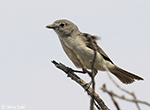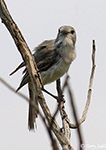| Length: 5.5 inches | Wingspan: 8 inches | Seasonality: Non-resident in South Dakota |
| ID Keys: Gray overall, white eye ring, underparts lighter, pale lores, very weak wingbar | ||
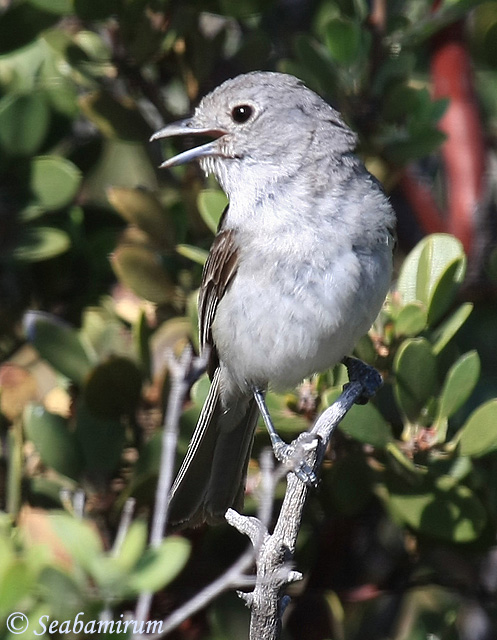 The
Gray Vireo is a rather nondescript vireo species of the southwestern United
States. They have a gray overall plumage without any strongly
contrasting plumage features, although a complete white eye-ring is usually
relatively obvious. They are mostly found in arid shrublands, where
they can be found actively moving through the foliage of shrubs and brush,
searching for insects. Unlike most other vireo species, they will also
sometimes feed directly on the ground as they search for insects.
The
Gray Vireo is a rather nondescript vireo species of the southwestern United
States. They have a gray overall plumage without any strongly
contrasting plumage features, although a complete white eye-ring is usually
relatively obvious. They are mostly found in arid shrublands, where
they can be found actively moving through the foliage of shrubs and brush,
searching for insects. Unlike most other vireo species, they will also
sometimes feed directly on the ground as they search for insects.
Habitat:
Found in a variety of dry, brushy habitats, including areas of chaparral, pinyon-juniper shrublands, or sagebrush and mesquite habitats. The preference is typically for areas of very dense vegetation.
Diet:
Feeds heavily on insects and spiders, but will also feed on berries, particularly during the winter months.
Behavior:
Forages by climbing and flitting through the foliage of shrubs and brush, searching for insects. They will also sometimes forage on the ground. They often flick their tail as they move about and forage, a movement not typically seen in vireos, and more often seen in Gnatcatchers, potentially causing identification confusion with those birds.
Nesting:
The nest of a Gray Vireo is a small cup built of grasses, weed stems, bark fibers, leaves, and spider webs, placed in the fork of a small branch. The female lays between 3 and 5 eggs, and both parents help to incubate them. When the eggs hatch, both parents help to feed the young. The young leave the nest after about 2 weeks. Gray Vireos may raise more than one brood per summer breeding season.
Song:
The song of a Gray Vireo is a deliberate series of musical phrases, chee-ree, chee-roo, generally with deliberate pauses in between the phrases. Contact calls and alarm calls are harsh or buzzy notes.
- Click here to hear the song of a Gray Vireo1
- Click here to hear the harsh alarm call of a Gray Vireo2
- Click here to hear a rapid, buzzier alarm call of a Gray Vireo3
Migration:
Migratory, but only moving short distances. Birds that summer in the United States mostly winter in northwestern Mexico, although some can be found in southern Arizona and southwest Texas.
Interactive eBird Map:
Click here to access an interactive eBird map of Gray Vireo sightings
Similar Species:
Gray's Vireo could be confused with other grayish vireo species in their range, or other small gray songbirds. Here are the species most likely to be confused with Gray Vireos:
- Bell's Vireo - Bell's Vireo have more of a brownish-gray tone than the colder pure gray of a Gray Vireo. Bell's Vireo also have less of complete eye-ring than does the Gray Vireo.
- Plumbeous Vireo - Plumbeous Vireos are one of the three vireo species formerly known as the "Solitary Vireo" before the species' were split. They are known for their "spectacled" look, a look that's lacking from the Gray Vireo. Plumbeous Vireo lack the white eye-ring of a Gray Vireo.
- Gray Flycatcher - Gray Flycatchers have a more pointed, flatter bill than the robust bill of a Gray Vireo. Gray Flycatchers also are a bit more brownish-gray than the slate gray of a Gray Vireo.
- Blue-gray Gnatcatcher - Another small gray songbird that may be found in the same areas as the Gray Vireo, Blue-gray Gnatcatchers have a thinner bill than the robust bill of a Gray Vireo. Blue-gray Gnatcatchers are also smaller, and have black inner tail feathers unlike a Gray Vireo.
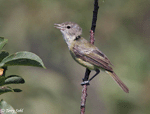 |
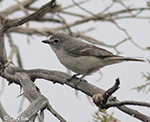 |
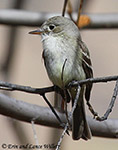 |
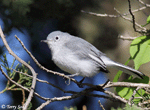 |
| Bell's Vireo | Plumbeous Vireo | Gray Flycatcher | Blue-Gray-Gnatcatcher |
Conservation Status:
Gray Vireos are relatively common in parts of their range, and systematic surveys in recent decades indicate overall populations may be increasing. The IUCN lists the Gray Vireo as a species of "Least Concern".
Further Information:
Photo Information:
Photo taken by "seabamirum" - Photo licensed under Creative Commons Attribution 2.0 Generic License.
Audio File Credits:
- 1Bobby Wilcox. Recorded in White Pine County, Nevada on June 8th, 2018. Original recording and information available from xeno-canto.
- 2Andrew Spencer. Recorded in Mesa County, Colorado on May 28th, 2012. Original recording and information available from xeno-canto.
- 3Andrew Spencer. Recorded in Mesa County, Colorado on May 1st, 2012. Original recording and information available from xeno-canto.
| Click below for a higher-resolution map |
 |
| South Dakota Status: Non-resident in South Dakota |
